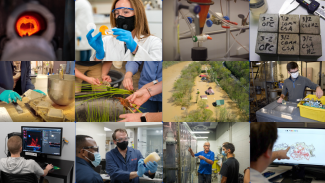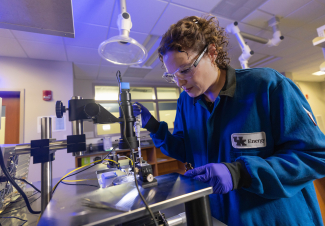By the Numbers
spent to carry out research & development in FY24
economic impact of UK R&D for Kentucky in FY24
created by UK R&D in Kentucky FY24
Federal Funding Fuels Innovation
As Kentucky’s flagship, land-grant institution, the University of Kentucky is charged with finding solutions to meet the needs of the Commonwealth. Federal funding is a key driver of scientific advancement across disciplines at UK, where scientists are addressing broad challenges that face both Kentucky and the nation.
As researchers at this university, we have the privilege of receiving funds from the National Institutes of Health (NIH), U.S. National Science Foundation (NSF), U.S. Department of Defense (DOD) and U.S. Department of Energy (DOE) to advance critical scientific research and fuel UK's mission to make Kentucky healthier, wealthier and wiser.
In fiscal year 2025, federal agencies awarded UK $255.3 million (51.4% of UK’s total awards for research). NIH funding made up $130.2 million of our federal awards. UK received $25.2 million from the NSF, $26.7 million from the DOD and $23.4 million from the DOE for a wide range of research projects.

Research Focused on Kentucky
Federal funding fuels world-class research at the University of Kentucky. From developing promising new treatments for cancer patients to driving a century of breakthroughs in agriculture, UK research teams with field-leading clinicians, scientists and engineers are working every day to address challenges facing Kentucky and the nation. The University of Kentucky is proud to have the support of a range of federal agencies that have invested critical dollars to find solutions for the next generation of needs across our commonwealth and beyond.

Guiding treatments
UK Markey Cancer Center researchers have discovered a genetic biomarker that could guide treatments for patients with the most aggressive form of brain cancer. Findings from this study, supported by the National Cancer Center (NCI), could help oncologists make better decisions for glioblastoma patients, potentially sparing them from harsh treatments and side effects. Read more about this research
Finding new approaches
UK’s Rick Honaker and Jack Groppo are testing out a new approach to mineral processing that uses about half of the energy and expands access to critical materials. With $3.5 million in funding from the Department of Energy, the team of engineers is working to find solutions to material needs for industry, manufacturing and energy. Read more about this research
Advancing sensors
Zan Paterson (above) is developing a new kind of sensor to convert noise pollution into electricity using advanced organic materials. Earning a Young Faculty Award from the Defense Advanced Research Projects Agency, this work could improve ocean mapping, support search and rescue operations, enable underwater communication networks and benefit industries like shipping and offshore construction. Read more about this research
Generating materials
With $2.3 million from the Department of Energy, UK’s John Balk is leading a team of engineers in developing next-generation materials critical to commercializing fusion power. The goal is to solve the challenge of containing a mini-star in a fusion reactor. This project showcases the expertise in materials science at UK and focuses on advancing U.S. energy technology. Read more about this research
Protecting service members
Musculoskeletal injuries in the military account for more than 2 million medical visits and $700 million in health care costs per year. UK’s Nicholas Heebner studies ways to support service members and reduce the risk of job-related injuries. This was the focus of a $3.4 million grant from the Air Force Research Laboratory to understand the health demands of special tactics support personnel. Read more about this research
Transforming agriculture
UK’s Research and Education Center is marking 100 years of groundbreaking agricultural research and educational support. From no-till and double-crop systems to improvements in beef cattle and fruit production, this research farm in Princeton, Kentucky has a long history of success thanks to decades of support from the USDA. Read more about this research